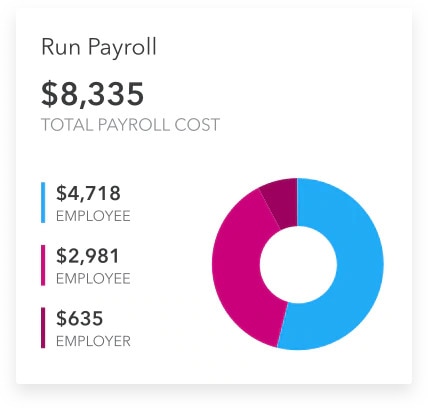Switching to less-frequent payroll periods can save time and money on payroll processing costs, but to navigate the change successfully, you need to recalculate payments, make changes to your accounting software, and communicate with your employees about the change.

Tips for Changing Payroll Frequency
Weekly Payroll
Sending out weekly pay cheques results in processing payroll 52 times per year and incurring the related service fees each week, whether you run payroll in-house or outsource it. Employees receive their pay cheques on the same day each week, often on Friday, for the salaries, hourly, and/or overtime pay they earned during the seven-day period the cheque covers.
Pros of Weekly Payroll
Many employees appreciate getting paid every week. It keeps a steady flow of money coming into their bank accounts, which can make it easier to budget household finances. When an hourly employee works overtime, they get paid for those extra hours sooner, rather than having to wait two weeks or even until the end of the month to get the extra money. That can be especially helpful if the weekly schedule varies significantly. For example, if an employee works 65 hours one week and only 25 hours the next week, it’s helpful to have that extra overtime pay before heading into the lighter schedule week. If you offer weekly payroll, you can expect high employee satisfaction.
On your end, calculating overtime is a straightforward process if you have hourly employees on staff. Since the pay period coincides with the work week, it’s easy to calculate any extra pay. With monthly pay periods, the first and last weeks of the month are often partial weeks, which can complicate your calculations. Weekly pay periods also make it easier to know when time cards or time reports are due. The due date remains the same every week since you run payroll on the same day each week. On a monthly schedule, the cutoff for turning in pay may vary from one month to the next, depending on when the end of the month falls.
Cons of Weekly Payroll
One of the biggest drawbacks of weekly payroll for you as the employer is the time and cost. Since you have to run payroll every week, that can take you away from other duties, or it means the staff member assigned to handle payroll gets pulled away from other duties. If you hire someone to do payroll, they get paid each time it’s run, increasing your overhead.
Distributing pay more frequently can also come at a cost if you issue traditional paper cheques, spending money on the cheque forms and the ink to print them. If you use direct deposit, you may have to pay a small fee per deposit depending on the service you use. Paying those fees every week adds up. You can potentially cut those fees in half by choosing biweekly or monthly pay periods.
Weekly to Biweekly Conversions
If you’re changing from a weekly to a biweekly pay period, the math is easy. With hourly employees, you continue to pay them for the time worked, and for salaried employees, you simply double the amount of their weekly paycheque. Then, you double insurance premiums or any other regular deductions you may withhold from your employees’ paycheques.
As Canada Pension Plan premiums and Employment Insurance are calculated as a percentage of earnings, you don’t have to worry about any special conversions. Similarly, if your employees accrue holiday pay as a percentage of time worked, you also don’t have to worry about converting these values either.
Biweekly Payroll
When you run payroll every other week, that results in 26 pay periods per year. Most months have two paydays, but some months have three. Just like a weekly pay period structure, the biweekly structure means your employees get paid on the same day of the week each time, but only every other week. So you might pay them every other Friday, for example.
This option is different than paying employees semimonthly, where they always get just two pay cheques per month, for a total of 24 pay periods. A semimonthly structure typically pays employees on the 15th and the last day of the month instead of paying every other week.
Pros of Biweekly Payroll
Compared to a weekly payroll schedule, biweekly payroll saves you a significant amount of time since you only have to run it every other week. You save money on direct deposits and cutting cheques, since you perform these tasks half as many times per year. Running payroll less often also means less risk of error.
If you’re running it weekly, you have more opportunities to introduce human error into the equation. Biweekly payroll also aligns well with the work weeks, which makes it easy to calculate overtime for the two weeks that fall into each pay period.
Cons of Biweekly Payroll
One drawback of biweekly payroll is aligning the monthly expenses with the pay periods. When you run payroll monthly, it’s easy to calculate monthly deductions. With weekly and biweekly payroll, the first and last pay periods of each month often actually span two different months. The first pay cheque in March may contain a few days from February, while the last pay cheque might include a few days from April, for example, adding some complexity to deduction calculations.
Biweekly to Semimonthly
With biweekly pay periods, you pay employees every two weeks, but with semimonthly periods, you pay employees twice a month. As a result, with a biweekly schedule, employees receive 26 paycheques per year, but with a semimonthly schedule, they receive 24.
To convert the new payment amount for salaried employees, multiply their biweekly salary by 26 and divide the result by 24. Alternatively, start with the annual salary and divide by 24. For example, if your employee’s biweekly paycheques are $2,000, he or she earns $52,000. When divided by 26, this results in semimonthly payments of $2,166.67.
You may also calculate regular deductions in the same way. For instance, if your employee currently pays $100 per biweekly paycheque for private health insurance, that equates to $2,600 per year. When you switch to semimonthly paycheques, you need to make that amount $108.33.
For hourly employees, you should simply continue to pay them by the hour, but you may need to convert some deductions as explained above. However, paying hourly employees semimonthly can be confusing as the pay period can end in the middle of the week, and that makes it hard to calculate overtime accurately. Because of that, this payroll schedule tends to work better for salaried employees.
Monthly Payroll
If you opt for a monthly payroll, you only run payroll once a month, and your employees only get one pay cheque per month for a total of 12 cheques per year. The specific date can vary. For example, you might run a payroll every month on the 20th. Monthly payroll isn’t as popular anymore. Employers don’t receive any huge benefits for only running payroll once per month, and it’s unpopular with employees due to difficulties in budgeting.
Pros of Monthly Payroll
Monthly payroll is relatively easy to handle. You only have to process it once per month, and it aligns well with any monthly payroll deductions you need to make, such as taxes, Canada Pension Plan (CPP) contributions, and Employment Insurance (EI) premiums. Instead of dividing those deductions over multiple cheques per month, you can take the full amount out of the single cheque for each employee.
Cons of Monthly Payroll
One of the biggest potential pitfalls of running a payroll just once a month is compliance with provincial laws. Many provinces allow monthly payroll, but others require you to pay your employees more frequently. In British Columbia, companies have to pay their employees at least twice per month. That means you need to at least opt for a semimonthly pay period, which means you pay your employees twice per month, often on the 15th and the last day of the month. Other provinces have different rules for salaried versus hourly employees. In Saskatchewan, if you employ monthly salaried employees, you can pay them on a monthly basis, but for all other employees, you need to pay at least semimonthly.
Another issue with monthly payroll is your employee satisfaction. It’s often not as easy for employees to stretch their money out over the entire month. In theory, since most bills occur on a monthly basis, they should be able to pay their bills when they get their pay cheque and budget the rest for other expenses. In practice, it’s challenging to ration the money for the entire month, especially for employees who live pay cheque to pay cheque. If they have difficulty establishing a monthly budget routine, they may have trouble getting by until they get paid again, causing them all kinds of hardships.
Choosing Between Payroll Options
Before looking at anything else, look at the payroll regulations in your province. Monthly payroll may not be an option if you run a business in a province that requires at least two pay periods per month. Once you familiarize yourself with the regulations, you can weigh the pros and cons of your specific circumstances. A frequent payroll period helps employees avoid having “more month at the end of the money,” as the saying goes.
Looking at the costs and time involved in different payroll options can help you decide what’s best for you. A biweekly pay structure is often a good balance between keeping employees happy and balancing your costs without adding to your bookkeeping or financial burden.
Software Changes
Most payroll software has a spot to enter pay periods, and you need to alter the information in this field when you change pay periods. For example, if you use QuickBooks Desktop, you can open an existing payroll schedule, hit edit, and then change the pay period. This program has a drop-down box with several options.
If you are switching from a weekly or biweekly to a semimonthly or monthly schedule, you also have to note the days of the month on which your pay periods fall. For instance, you may select the first and 15th of every month.
Transitioning Employees
Ideally, you should not spring a shift in payroll periods on your employees. Instead, notify employees at least a month in advance, and let them know exactly how the change will affect them. For example, when switching from biweekly to semimonthly, explain that employees will receive larger paycheques but will receive two fewer cheques per year.
Likewise, if you outsource payroll, your supplier handles the changes in calculations. Keep in mind you may have to pay more if you increase the frequency of payroll because your provider may charge for each run.
When deciding on the frequency of pay periods, you’re ultimately trying to find a balance between a cost-effective solution for you and a schedule that keeps your workforce happy.
Weighing the pros and cons of different frequencies helps you find that balance, and finding the right payroll solutions makes it easier to process payroll no matter how often you do it. Did you know you can pay employees in QuickBooks? Add Payroll today.



